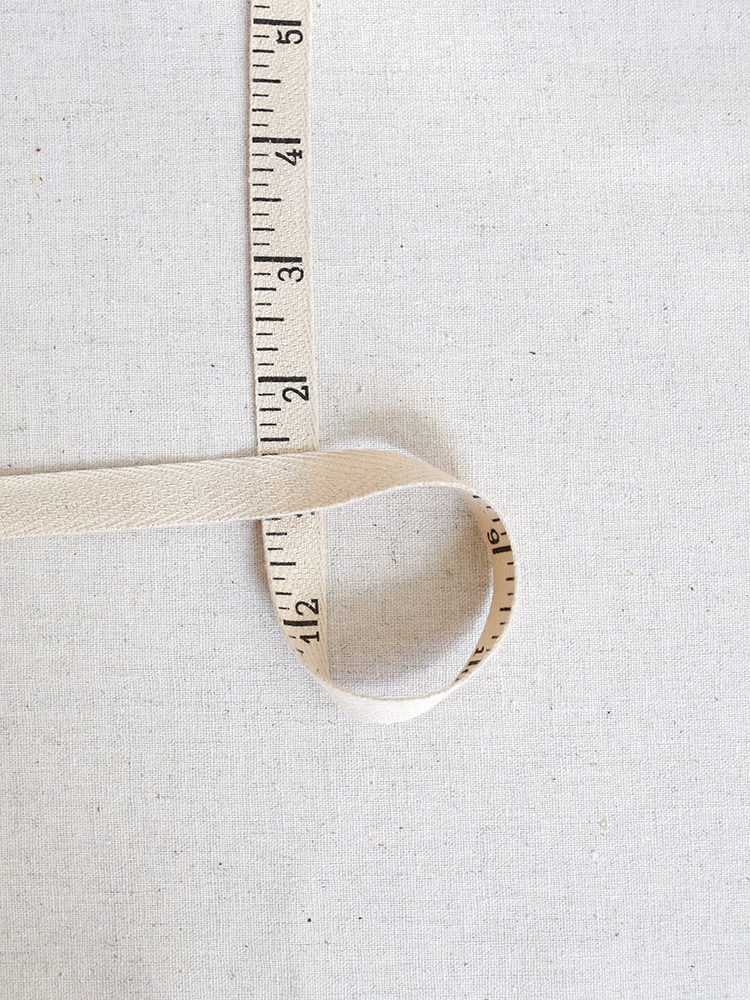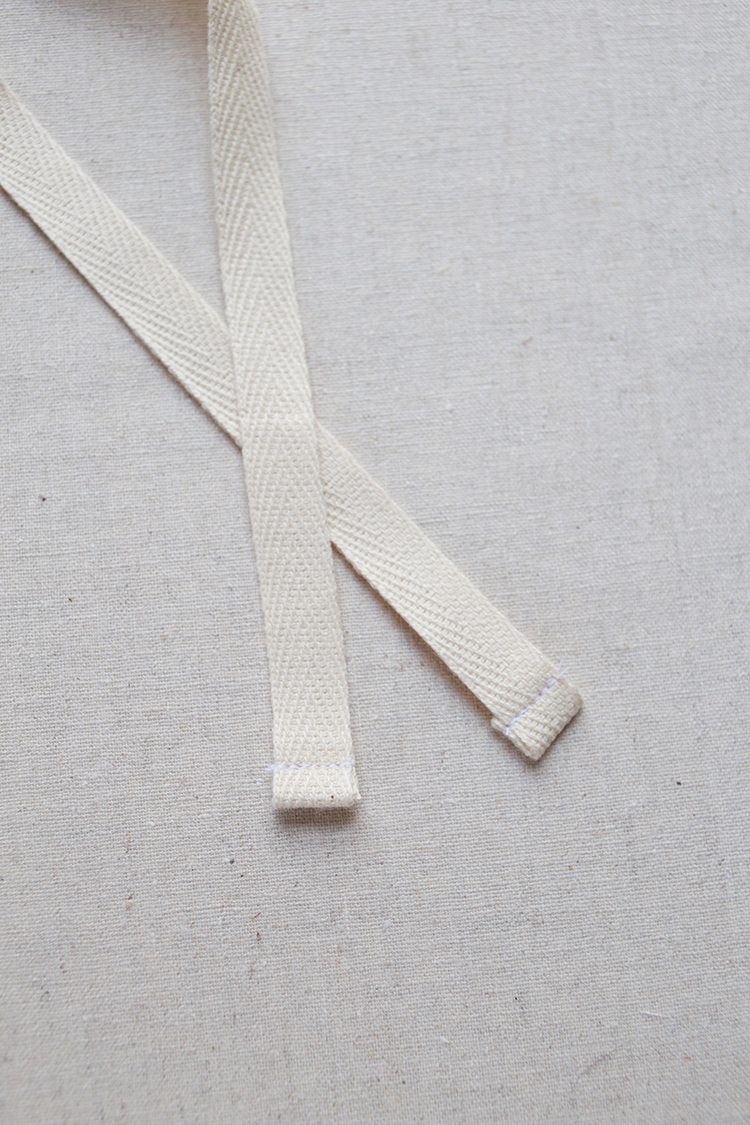
Welcome to the fourth week of the Lined Drawstring Bag Sew Along! Today I'm sharing all about twill tape and how to use it for drawstring bags!
I'll be updating the Sew Along Page each week with all the posts so that you can easily catch up or reference these posts after the sew along ends!
I hope you'll sew along with us! Sew from the tutorial or the patterns:
Lined Drawstring Bag Tutorial
Lined Drawstring Bag Pattern
Lined Drawstring Bag Expansion Pattern
Before we dive into today's post, let's quickly chat about our to-do for week 4 of the sew along!

This week's focus is on final touches! Tackle those drawstring casings, make fabric ties or prep twill/paracord ties. Pull ties through the bags and finish them off with a simple knot or some fun beads! A few posts you might find helpful when tackling this:
- Marking the drawstring casings can be time consuming, especially if you're making a lot of bags. I have a video tutorial for an alternative marking technique that is my go-to method. Find it here: Alternative Method for Marking the Drawstring Casing
- If you're like me and you don't have a free-arm on your sewing machine, I have a video tutorial for how to sew the drawstring casings. Find it here: How to Sew a Drawstring Casing Without a Free-Arm Sewing Machine
- Using beads and want to take them to the next level? I have a tutorial all about how to customize unfinished wooden beads. Find it here: How to Customize Wooden Beads with Paint, Stain, and Dye
- You've made your bags and now you're ready to gift them. How about use some reusable gift tags too! I share five different ideas for tagging your bags in this post: Reusable Gift Tag Ideas for Drawstring Bags
- Working with Paracord can be intimidating if you've never used it before, I've got a post that breaks down the basics for you: Tips for Working with Paracord
What is Twill Tape?

Twill tape is a woven fabric tape (ribbon), usually woven in a herringbone design. It's often made from cotton, linen, polyester or wool. It has many uses in sewing, including reinforcing or finishing seams, making casings, binding, and as ties or drawstrings!
Not only does Twill tape come in different substrates, it can be different widths, colors, and have designs printed on them.
Where to Buy Twill Tape

Cotton twill tape is widely available online and can be found in some stores as well. Here are a few places to look:
- I sell a small selection of twill tapes in my online shop.
- Your local independent fabric/quilt shop.
- Etsy* is a great place to find a wide variety of twill tape.
- Big box craft stores like Joann Fabrics usually sells it by the yard.
Four Ways to Finish Twill Tape Ends
When using twill tape for drawstring bag ties, you'll want to finish the cut ends. There are many different ways you can do this, I'm going to share four here, in order of ease/effort:
1. Fray Check (or Clear Nail Polish)


Use a small amount of fray check or clear nail polish on each cut end to keep from unraveling.
2. Washi/Masking Tape


Cut a small piece of washi tape that's at least twice the width of the twill tape (so 1"+ if you're using 1/2" twill). Place the tape on one of the cut ends, so that it extends past the twill. Wrap the tape around the twill and press well with your finger. Trim the end with scissors to tidy.
3. Fold Over and Stitch




This is what I do 90% off the time. On each end, fold the twill under by about 3/8", then fold it under 3/8" again, trapping the raw edge inside. Topstitch to secure in place.
4. Fabric Square Tie





Cut (2) 1.25"x2.5" rectangles. Press each long edge in 1/4". Press each short edge in 1/4". Fold in half so the two short ends meet, press. After threading the ties through the casing on the bag, sandwich the two tie ends on one side between one of the fabric piece. Secure with pins, topstitch around all four sides. Repeat with the ties on the other side of the bag.
Threading the Drawstrings

My favorite way to thread the drawstring ties (twill or not) is to use a big 2" safety pin. If I'm folding over and stitching the ends to finish, I do this first before threading. For all the other finishing methods, I thread the drawstrings into the bag before finishing to get the neatest result.
I now have small packs of 2" safety pins in my online shop! I know not everyone wants to buy a big pack these large pins. This way you can have just a few on hand for this task. Find them here: Safety Pins for Drawstring Bags
Using Twill Tape for a Tag

Make a little tag with twill tape to use on your bags! If your twill tape is really tightly woven, you may even be able to use a little stamp to customize the tag. Regardless, it's just a fun little detail. You can do this step either before any of the sewing instructions or after step 2.


Cut a piece of twill your desired length, I cut mine about 2" long. Fold in half with wrong sides together and press well. Decide where you want your tag to go. I wanted mine down near the bottom of the bag. Just make sure you're not going to interfere with the gussets. If you're measuring up from the bottom of the Exterior Main, take half the depth measurement and add around an inch. That's the closest I'd go to the bottom! Place the folded twill with the raw edge on the raw edge of the Exterior Main and baste in place. Finish the bag as usual.
Using Twill Tape for Embellishment

A few years ago I shared a post during the sew along for embellishing drawstring bags with twill or ribbon! I think it's a really cute detail you can add to a bag. Use it to cover the seam between the Exterior Main and the Exterior Accent, or use it around the drawstring casing!
Using Twill Tape with Beads

I love adding wooden beads to my bags to dress them up even more! My one piece of advice when using beads with twill tape (this applies to paracord and even fabrics ties too) is to give yourself a little extra length to accomodate the beads. I often like to tie a knot on either side of the bead, so that uses up some of the drawstring length. I'd cut the ties a couple of inches longer than the pattern calls for.
If you need help getting the twill threaded through the bead, you may find a point turner or chopstitck helpful for pushing it through. Take care of tie a large enough knot to keep the bead from falling off!
I hope you've enjoyed this informational posts! I've loved seeing your bags throughout the sew along, please share them with me on instagram @jenib320 + #lineddrawstringbag or via email (jenib320 @ gmail.com)!









